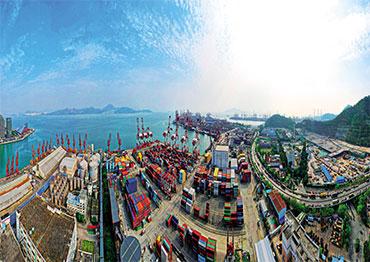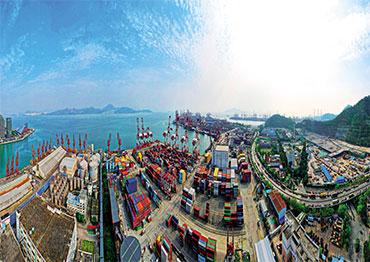In contrast to the declining exports from China, exports from other Southeast Asian countries and regions increased sharply entering 2022. Since March, Indonesia’s exports grew by over 40 percent and Vietnam’s increased by 30 percent, while exports from Malaysia, Thailand and the Philippines grew by around 20 percent, according to an analysis published by Huaxi Securities in May.
Many enterprises NewsChina interviewed said they have been affected by orders moving to Southeast Asia and Mexico in the past few months.
Yang Hui said that in the last two years, global buyers have turned to suppliers in countries like India, Vietnam and Thailand for products with lower technology and quality requirements. “The price of our products is relatively high due to rising costs across many metrics. Countries like Vietnam, India and Thailand have price advantages over China as the cost of labor and investment in equipment is lower,” Yang said.
The pandemic has made the situation worse, Yang noted. Besides supply chain disruption and logistics problems, it is difficult to fulfill after-sale service commitments like debugging. “Even if our engineers are willing to travel abroad despite all the Covid-induced troubles, the cost is high. Previously we paid an engineer US$50 a day, now the price is about US$300. Plane tickets remain expensive too,” Yang said.
China still imposes strict flight quotas on airlines, and flights are suspended if too many Covid cases are detected among inbound passengers. There are also quarantine stays in hotels in the port of entry to pay for, and possibly again in the engineer’s destination, although China has recently reduced the length of quarantine for inbound passengers in some cities.
In 2021, Yang went to Bangladesh to visit a customer. The customer bought equipment from China in 2020 but was unable to get debugging help from the supplier after the pandemic erupted, so he took his business to an Indian supplier in 2021. “If India is not available, they will turn to Turkey or countries in Europe, even at a higher cost, because even in the worst times of the pandemic, European suppliers promised to provide debugging services,” Yang said.
“While Covid-related restrictions in China have not been lifted, other countries have lifted them. It puts China at a disadvantage,” Yang said.
But some are not so worried about the situation. “Southeast Asian countries like Vietnam might be able to partly replace the industrial chain in China, but not all of it, because of their population base,” Liu Yongbin said, adding that Vietnam still depends on China for industrial support. “It buys much of its industrial machinery for manufacturing from China second-hand and its industrial chain is incomplete,” Liu said.
Zhang Yuanqing, a furniture manufacturer from Guangdong, agreed that while the labor-intensive industrial chain is shifting to Southeast Asian regions, they still fall behind China in terms of resources in the short run. “But the region is catching up,” Zhang said.
A report published by Huaxi Securities in May shows that in Southeast Asian countries, the growth of exports in March and April is mainly reflected in metals and minerals, textiles and clothing and electronic products. In recent years, smartphone making has shifted from China to India and Vietnam, decreasing China’s share in global phone production capacity from 90 percent at the highest to 70 percent in 2021. International media reported on June 1 that Apple is planning to shift some iPad capacity from China to Vietnam, although the tech firm has not yet confirmed the report.
On April 11, Apple announced it would manufacture the iPhone 13 in India to meet market demand in India, the US and other markets. In the same month, China’s exports of machinery and electronic products to India increased, indicating that India’s manufacturing is recovering from the pandemic. Many phone brands like Samsung and Xiaomi have built factories in India and local industrial support is improving.
Gao Shiwang noted that while China’s share of global computer and phone exports is large, the production focus is on processing and assembling with low added value. Production of capital and technology-intensive integrated circuits and semiconductors still relies on imports. “China needs to go upward in the industrial chain by attracting foreign capital and updating technology,” Gao said.
Bai Ming, vice director of international market research at the Chinese Academy of International Trade and Economic Cooperation, noted that even though China’s exports were hit hard by the Covid resurgence in March and April, the pandemic is just one of many factors affecting the industrial and supply chains. “Southeast Asian countries might be too small to reach economies of scale on their own, but if the ASEAN community works together, it could speed up industrial support,” Bai said. He suggested companies producing labor-intensive products transfer to China’s central, western and northeastern regions because of cheaper labor and other input costs, such as power, or transfer their industrial chains to Southeast Asia or Mexico.
In response to losing export orders, the Ministry of Commerce said it will try every means to help companies tap markets through big exhibitions like the Canton Fair and will help SMEs attend exhibitions overseas.
To address surging freight and raw material costs, Gao suggested authorities enhance the coordination of international shipping capacity, guide China-invested companies to reinforce business in overseas ports, increase shipping support for Chinese brand companies that go international, provide guarantees for key industries in terms of freight and shipping capacity, and enhance the stable supply of bulk commodities.
Yang told NewsChina that the situation started to improve in May as production and logistics resumed. “When we need to load goods in a place, we just apply to the local government in advance and we can transport cargo direct to Shanghai Port. The cost of raw materials and freight fell too,” he said.
Liu is not too optimistic about the second half of 2022, predicting that exports will reach only half the volume of 2021. The CCCME predicted that Q2 export growth will continue to fall because of the suspension of production and blocked logistics in March and April.
Yang worries more about the declining confidence in Chinese suppliers that he has sensed in the past two years, which makes him feel helpless sometimes. “We can only try our best to keep our existing customers and be as responsive as possible,” he said.
He has been actively setting up overseas offices since 2021 to enable his company to provide swift maintenance services to his overseas clients.

 Old Version
Old Version

